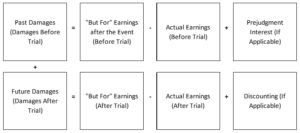
Damages Quantification
Damages quantification operates on the premise that the defendant is liable for damages from the defendant’s harmful act. The plaintiff is entitled to recover monetary damages for losses occurring before and possibly after the time of the trial. The goal of damages measurement is to find the plaintiff’s loss of economic value from the defendant’s harmful act. The loss of value is sometimes the diminished market value of a business or property, or it may take the form of a reduced stream of profit or earnings. The losses are net of any costs avoided because of the harmful act. The essential elements are the quantification of the reduction in economic value, the calculation of interest on past losses, and the application of financial discounting on future losses. The losses are the difference between the value the plaintiff would have received if the harmful event had not occurred and the value the plaintiff has or will receive, given the harmful event. The plaintiff may be entitled to interest for losses occurring before trial. Losses occurring after trial are usually discounted to the time of trial. The plaintiff may be due interest on the judgment from the time of trial to the time the defendant actually pays. A summary of the damages model is displayed below:
Damages Model


Comments are closed.